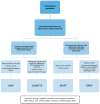Unravelling Genetic Factors Underlying Corticobasal Syndrome: A Systematic Review
- PMID: 33467748
- PMCID: PMC7830591
- DOI: 10.3390/cells10010171
Unravelling Genetic Factors Underlying Corticobasal Syndrome: A Systematic Review
Abstract
Corticobasal syndrome (CBS) is an atypical parkinsonian presentation characterized by heterogeneous clinical features and different underlying neuropathology. Most CBS cases are sporadic; nevertheless, reports of families and isolated individuals with genetically determined CBS have been reported. In this systematic review, we analyze the demographical, clinical, radiological, and anatomopathological features of genetically confirmed cases of CBS. A systematic search was performed using the PubMed, EMBASE, and Cochrane Library databases, included all publications in English from 1 January 1999 through 1 August 2020. We found forty publications with fifty-eight eligible cases. A second search for publications dealing with genetic risk factors for CBS led to the review of eight additional articles. GRN was the most common gene involved in CBS, representing 28 out of 58 cases, followed by MAPT, C9ORF72, and PRNP. A set of symptoms was shown to be significantly more common in GRN-CBS patients, including visuospatial impairment, behavioral changes, aphasia, and language alterations. In addition, specific demographical, clinical, biochemical, and radiological features may suggest mutations in other genes. We suggest a diagnostic algorithm to help in identifying potential genetic cases of CBS in order to improve the diagnostic accuracy and to better understand the still poorly defined underlying pathogenetic process.
Keywords: CBS; atypical parkinsonism; corticobasal degeneration; corticobasal syndrome; genetics.
Conflict of interest statement
The authors declare no conflict of interest.
Figures


References
-
- Boxer A.L., Geschwind M.D., Belfor N., Gorno-Tempini M.L., Schauer G.F., Miller B.L., Weiner M.W., Rosen H.J. Patterns of Brain Atrophy That Differentiate Corticobasal Degeneration Syndrome From Progressive Supranuclear Palsy. Arch. Neurol. 2006;63:81–86. doi: 10.1001/archneur.63.1.81. - DOI - PubMed
-
- Togasaki D.M., Tanner C.M. Epidemiologic aspects. Adv. Neurol. 2000;82:53–59. - PubMed
-
- Wenning G.K., Litvan I., Jankovic J., Granata R., Mangone C.A., McKee A., Poewe W., Jellinger K., Chaudhuri K.R., D’Olhaberriague L., et al. Natural history and survival of 14 patients with corticobasal degeneration confirmed at postmortem examination. J. Neurol. Neurosurg. Psychiatry. 1998;64:184–189. doi: 10.1136/jnnp.64.2.184. - DOI - PMC - PubMed
Publication types
MeSH terms
Substances
LinkOut - more resources
Full Text Sources
Other Literature Sources
Medical
Miscellaneous

